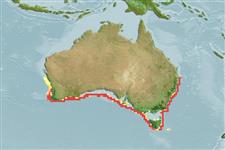Common names from other countries
Elasmobranchii (sharks and rays) >
Rajiformes (Skates and rays) >
Rajidae (Skates)
Etymology: Dipturus: Greek, di = two + Greek, pteryx = fin (Ref. 45335).
More on author: Whitley.
Environment: milieu / climate zone / depth range / distribution range
Ecology
Marine; bathydemersal; depth range 160 - 765 m (Ref. 114953), usually 400 - 550 m (Ref. 6871). Temperate; 28°S - 44°S, 112°E - 155°E (Ref. 114953)
Indo-West Pacific: southern Australia, from Western Australia to New South Wales.
Length at first maturity / Size / Weight / Age
Maturity: Lm ?, range 127 - ? cm
Max length : 184 cm TL male/unsexed; (Ref. 114953)
Occur over soft bottoms of the continental slope (Ref. 7300, 75154). Mainly feeds on small bony fishes (Ref. 114953). Oviparous (Ref. 50449). Eggs have horn-like projections on the shell (Ref. 205); egg cases ca. 19 cm long (Ref. 114953). This species reaches maturity at ca. 13 years. Length of mature males at ca. 120 cm TL; young hatch at ca. 26 cm TL (Ref. 114953).
Life cycle and mating behavior
Maturities | Reproduction | Spawnings | Egg(s) | Fecundities | Larvae
Oviparous, paired eggs are laid. Embryos feed solely on yolk (Ref. 50449).
McEachran, J.D. and K.A. Dunn, 1998. Phylogenetic analysis of skates, a morphologically conservative clade of elasmobranchs (Chondrichthyes: Rajidae). Copeia 1998(2):271-290. (Ref. 27314)
IUCN Red List Status (Ref. 130435)
CITES (Ref. 128078)
Not Evaluated
Threat to humans
Harmless
Human uses
Tools
Special reports
Download XML
Internet sources
Estimates based on models
Preferred temperature (Ref.
115969): 7.8 - 10.8, mean 9.5 (based on 33 cells).
Phylogenetic diversity index (Ref.
82804): PD
50 = 0.5000 [Uniqueness, from 0.5 = low to 2.0 = high].
Bayesian length-weight: a=0.00282 (0.00133 - 0.00596), b=3.25 (3.08 - 3.42), in cm Total Length, based on LWR estimates for this Genus-body shape (Ref.
93245).
Trophic level (Ref.
69278): 4.0 ±0.6 se; based on size and trophs of closest relatives
Resilience (Ref.
120179): Low, minimum population doubling time 4.5 - 14 years (Assuming fecundity<100).
Fishing Vulnerability (Ref.
59153): Very high vulnerability (90 of 100).
